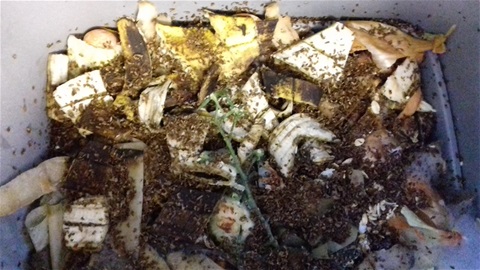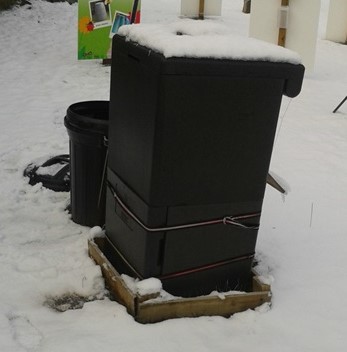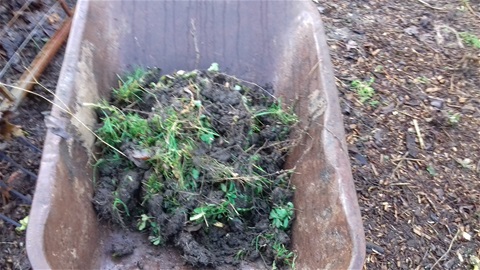Christmas Blog 3 . Composting and Recycling Non-food Christmas Waste
We can all minimise our Christmas carbon footprint by not wasting food (See separate blog) and by reducing, composting and recycling other Christmas waste.
Send photos of your efforts to compost Christmas waste to carryoncomposting1@gmail.com
or post them at https://www.facebook.com/carryoncomposting/
Baubles Glass and plastic baubles are not compostable and are not usually recyclable. Glass baubles should be wrapped up and placed in the general waste. Most Plastic baubles are not recyclable (check the label), will have to go to landfill. If plastic or glass baubles are in good condition, they are best saved and donated to a local charity shop next year.
Batteries are not compostable. Used batteries should be taken to a collection point at the recycling depot or some electrical shops.
Cardboard is compostable, with corrugated boxes being a particularly excellent source of carbon rich “browns” . The boxes should be torn or cut into smallish pieces and scrunched up when added to the bin. If the cardboard is being sent to be recycled flatten the boxes to save space and keep them dry, as if they get wet and go mouldy, they cannot be recycled. However, is best made wet cardboard before being composted. Plastic film and sticky tape should be removed from paper and card packaging before recycling. It is best to remove it from items being composted as otherwise it will appear in the finished compost.
Christmas cards Many people are sending ‘e’ cards now, but computer use also has an environmental cost. Buy cards that are Forest Stewardship Council certified, this ensures the paper used has been sustainably and ethically produced.
When Christmas is over cards should be reused, composted, or recycled. There are many crafting activities using cards for children interested in reducing waste e.g. making gift tags. paper chains or cut out the images to make cards for next year.
As a composter the first choice should be composting, cardboard is a good source of winter browns. Cards can also be recycled. Avoid buying, or separate, cards that have added glitter, bows, or shiny metallic finishes as these are not compostable or recyclable and so should be sent to landfill. Unfortunately, most glitter cannot be processed in recycling plants as it clogs up the equipment, but the backs of paper Christmas cards without a coating or glitter can be composted or added to the L.A. bag or box recycling collection (see Glitter below).
If the card looks as if it is metallic or contains plastic or laminated materials do a scrunch test. If it does not stay scrunched the card cannot be composted or recycled.
The volume of waste wrapping can be reduced by giving presents in bags that can be reused next year saving on paper and waste.
Christmas trees can be composted but they need shredding first to increase the surface area exposed to the composting microbes and speed decomposition. If a shredder is not available branches can be cut into small “thumb” size pieces, but these will be slow to compost, and it is easier to donate the tree to the Local Authority to be shredded into chippings which are then used in parks etc. Local authorities often arrange drop-off points or special collections of 'real' trees in early January. Check your local authority website for more information. If the council does not offer a system for dealing with Christmas trees they can be cut into small pieces and put in the garden waste bin.
Pine needles can be composted or turned to leafmould, but they will be slow to decompose, and any significant quantities are best treated separately from deciduous leaves.
Unfortunately, artificial trees, most of which are made from the dreaded plastic face only one possible destination when their final day arrives: landfill. If you have an artificial tree, the best thing to do is use it for as many seasons as possible, they can last 15+ years, or donate it to someone else who will use it. ( Many areas have a Freecycle type network on social media).
Corks Natural corks can be composted but will take a time to break down and might need returning to the bin for a second session when the compost is harvested. A glass of wine while sorting the corks can be helpful.
Electronics. Electronic items may not immediately come to mind as being Christmas waste but so many people get new electronic gadgets as Christmas gifts large numbers of electrical items are disposed of immediately after the festive season. Use any upcycling services in your area if possible or any separate area for working electrical items at the recycling centres. Christmas tree lights are recyclable but need to be taken to a Waste Electrical and Electronic Equipment (WEEE) recycling centre. When buying replacements, choose LED lights which use less electricity than older incandescent types. Remove batteries from anything that is likely to be stored for next year and use them elsewhere until they run out of power. When disposing of the batteries keep them separate from the other waste materials recycling them at the nearest battery collection point.
Gift tags etc. Tags made from card can be cut up and composted having first removed any plastic ties. Plastic or foil tags will not compost.
Glitter Large numbers of Christmas items are decorated with glitter, including cards, wrapping paper and decorations. Most of the glitter contains microplastic which does not compost or be recycled. Items containing glitter should be put into a sealed container such as a plastic bag, that is being binned anyway, and put into the landfill collection system. Make a note not to buy glitter next year.
Biodegradable glitter made from a certified compostable film that meets the European (EN13432) and the American (ASTM D6400) standards
is available but may require a little effort to find.
Eco glitter is made of a cellulose film mainly derived from eucalyptus trees from sustainably sourced FSC plantations and is designed to break-down in the sewage system. The product sold in the USA
is certified as home compostable.
However, recent research suggests that biodegradable alternatives may be little or no better for the environment than “traditional” PET glitter in respect to the effects on root length and chlorophyll levels being almost identical to those of traditional glitter. Research led by Dr Dannielle Green of Anglia Ruskin University and published in the Journal of Hazardous Materials (Vol 402. 124070) indicates after 36 days, the presence of glitter halved the root length of common duckweed (Lemna minor), while levels of chlorophyll in the water were three times lower than in control conditions, indicating reduced levels of phytoplankton, or microalgae.
Paper Chains. Paper chains with prints or colours are not ideal for recycling and are probably best off in the compost bin.
Paper napkins and party hats from the crackers can be composted.
Presents. There are 60 million unwanted gifts each Christmas. Next year minimise waste by checking what presents the recipient wants. If it is a low-cost token gift, try to avoid tat and opt for items with minimal waste. Avoid buying novelty Christmas jumpers and other clothing as gifts that will only be worn once or twice before replaced with next years model. If you are disposing of novelty clothing take it to a charity shop in October
Ribbons and decorations. Ribbon bows and other accessories cannot be recycled but they can be reused, so keep them safe for next year. Ribbons and bows made of natural fibres can be composted but many will contain foil or plastic and cannot be composted or recycled. Decorations are reusable, keep them and in years to come, as an antique, they may be worth what you paid for them
Wood ash from open fires or wood burners can be composted if mixed with other materials.
Wood Cocktail sticks although small can be composted. To avoid pets trying to eat them and injuring themselves put the sticks into a container and empty it directly into the kitchen caddy. Holly, ivy, and mistletoe can be composted. The holly is best shredded.
Wrapping paper and boxes When buyingwrapping paper check that it is labelled ‘recyclable’. There is a growing movement to provide this information on the packaging so keep an eye out when choosing yours. Paper and card are a good source of “browns” and can help create air pockets in the compost bin. If possible, use string rather than sticky tape, ribbons and bows as these will need removing before composting or recycling. Plastic tape does not breakdown during composting so if it goes into the compost bin it will be in the compost when you use it. Some paper and cards will contain plastic or laminated materials which cannot be composted or recycled. Scrunch the item up in your hand. If it stays 'scrunched' it can be composted or recycled. Paper can be shredded and used as protective packaging around future gifts, or even as a “cloth” for cleaning window and mirrors.
Wreaths Christmas wreaths made from plant materials can be composted after any glue, plastic and wiring are removed. If leaves have been coated with glitter discard them to landfill. Most council will accept “clean” Christmas wreaths as garden waste.
Further information on Christmas Composting and a wide range of other compost topics plus talks for Garden Clubs and Allotment Societies and sessions for schools can be found at www.carryoncomposting.com
New to composting? Practical training sessions can be arranged (when Regulations allow) at our Composting Demonstration site at Stokes Wood Allotments Leicester


